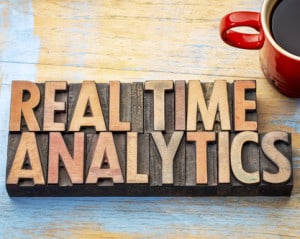
Today’s enterprises demand real-time graph analytics capabilities that can explore, discover and predict very complex relationships.
Graph databases offer an ideal technology for analyzing and answering complex questions pertaining to the relationships and connections among large data sets. However, their effectiveness to deliver real-time insights depends on a key feature: the number of hops of traversal (i.e., the degrees of separation possible in a big graph).
Graphs overcome the challenge of storing massive, complex and interconnected data by storing data in a format that includes nodes, edges and properties. They offer several advantages over traditional RDBMS and newer big data products, including better suitability for relationship analysis to support real-time analytics.
But, traditional graph technologies have not fulfilled the promise of real-time analytics because they cannot support three or more hops of traversal for big graphs. Solutions thus far have been slow and offer limited analysis for big graphs. Other limitations include trouble loading large quantities of data, inability to deliver fast graph traversal speed and poor ingestion of data in real-time.
With increasing real-time data so prevalent in enterprise ecosystems, it’s time for graph databases to grow up.
Introducing Real-Time Deep Link Analytics
Indeed, today’s enterprises demand real-time graph analytic capabilities that can explore, discover and predict very complex relationships. This represents Real-Time Deep Link Analytics which is achieved utilizing three to 10+ hops of traversal across a big graph, along with fast graph traversal speed and data updates.
Let’s consider a simple personalized recommendation such as “customers who liked what you liked also bought these items.” Starting from a person, the query first identifies items you’ve viewed / liked / bought.
Second, it finds other people who have viewed / liked / bought those items.
Third, it identifies additional items bought by those people.
Person → Product → (other)Persons → (other) Products
This query requires three hops in real-time, so it is beyond the two-hop limitation of current-generation graph technology on larger data sets. Adding in another relationship easily extends the query to four or more hops.
As each additional hop reveals new connections and hidden insight from within colossal amounts of data, Real-Time Deep Link Analytics represents the next stage and evolution of graph analytics. In particular, Real-Time Deep Link Analytics offers huge advantages for use cases including: fraud prevention, personalized recommendation, supply-chain optimization, and other analysis capabilities needed for today’s most critical enterprise applications. Here’s a look at how:
Risk & Fraud Control
Real-Time Deep Link Analytics combats financial crime by identifying high-risk transactions. For example, starting from an incoming credit card transaction, how this transaction is related to other entities can be identified as follows:
New Transaction → Credit Card → Cardholder → (other)Credit Cards → (other)Bad Transactions
This query uses four hops to find connections only one card away from the incoming transaction. Today’s fraudsters try to disguise their activity by having circuitous connections between themselves and known bad activity or bad actors. Any individual connecting the path can appear innocent, but if multiple paths from A to B can be found, the likelihood of fraud increases.
Given this, more hops are needed to find connections two or more transactions away. This traversal pattern applies to many other use cases — where you can simply replace the transaction with a web click event, a phone call record or a money transfer. With Real-Time Deep Link Analytics, multiple, hidden connections are uncovered and fraud is minimized.
Multiple-Dimensional Personalized Recommendations
Real-Time Deep Link Analytics enable queries to find similar customers or to provide personalized recommendations for products. Consider the following examples of recommendation paths, all of which are longer than three hops:
Person→ Purchases→ Products→ (other)Purchases→ (other)Persons→ (other)Products
Person → Purchases→ Products→ Categories→ (other)Products
Person→ Clicks→ Products→ Categories→ (other)Products
Any of the above paths can be used for personalized recommendations on a retail website, for example, either individually or in combination with each other. The first path selects products bought by other users who bought the same products you bought. The second determines products similar to the products you bought, and the third determines products similar to the products you viewed/are interested in. A recommendation algorithm can assign different weights at run time to products found in each type of path to give a user a mixed ensemble of products for recommendation.
However, due to limitations in current systems, the vast majority of current recommendation functions use offline computation. As recommendations are computed in the background they are unable to perform real-time, on-demand analytics using the latest data. This has been a setback that new graph database technology is now able to address.
Power Flow Optimization, Supply-Chain Logistics, Road Traffic Optimization
These applications adjust each entity and/or each connect, until a dynamic equilibrium or optimization is established. For example, in a national or regional power grid, the power output of each generator is adjusted.
All Entities
→ relationship to and effect on neighbors
→ Update All Entities
<repeat until a stable state is achieved>.
Finding the right values inherently requires iterative computation in a graph (similar to PageRank) until some metric values converge. Moreover, each top-level component (e.g., a power generator), is the hub for a network of supporting elements, resulting in a multi-tier mesh. A power distribution network could easily have a six-hop path.
Power generator→ Transformers→ Control units→ Lower-level transformers→ Lower-level control units→ Meters→ Power-consuming devices
Real-Time Deep Link Analytics is needed for a graph database system to handle this level of computation.
A Transformational Technology for Real-Time Insights and Enterprise AI
What enterprises currently get from limited graph analytics is only the tip of iceberg compared to what Real-Time Deep link Analytics can provide. By supporting all connections between data entities, Real-Time Deep Link Analytics offers a truly transformative technology, particularly for organizations with colossal amounts of data.
The entry of Real-Time Deep Analytics represents a new era of graph analytic technology. As the next stage in the graph database revolution, it is empowering users to explore, discover and predict relationships more accurately, more quickly and with more insight than ever before. The result is real-time support for enterprise AI applications – a true game changer in today’s competitive market moving at the pace of now.





























